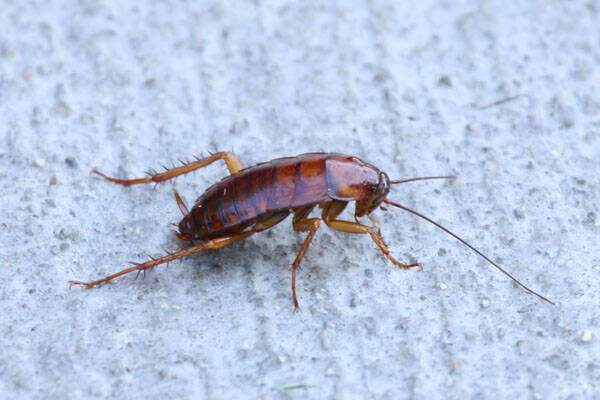Blatta orientalis
IUCN
LCBasic Information
Scientific classification
- name:Blatta orientalis
- Scientific Name:Blatta orientalis,Oriental cockroach, Blatta orientalis
- Outline:Arthropoda
- Family:Insecta Blattaria Blatta
Vital signs
- length:1.9-2.5cm
- Weight:0.45-0.95g
- lifetime:1-2years
Feature
The largest cockroach in the world
Distribution and Habitat
Oriental cockroaches are found all over the world. There is almost no country without this insect. They are widely distributed in the northern temperate zone. Combined with the German cockroach, the distribution range of Oriental cockroaches accounted for about 10% of the land area in 1968. Although their name makes them look like they are from the East, Oriental cockroaches are believed to have originated in Africa.
Oriental cockroaches are household species, but they are also found outdoors. They prefer a cool environment, preferably 20-29℃, and are not strict about humidity. They often live in basements, cellars, roofs, drains, sewers, wall cracks, floors, masonry, fallen leaves, under tree bark, and other favorable environments.
Appearance
The body is medium-sized, with a body length of 19-25mm. The male and female are obviously different. The body is brown-black to dark reddish brown. The top of the head and the compound eyes are brown-black, the upper lip is dark brown, and the lower jaw is brown. The pronotum is trapezoidal, dark brown, and the front and rear edges are arc-shaped. The male forewings are dark brown, shorter than the abdomen, and only cover 2/3 of the abdomen; the hind wings are slightly shorter than the forewings; there is nothing special about the abdominal segments, only the ninth segment has a slow arc at the concave rear edge; the supra-anal plate is transversely wide and trapezoidal, with slightly concave edges on both sides, the rear edge is almost straight, and there is a notch in the center; the tail is brown-black; the lower genital plate is wide; the foot is dark brown, the claw pad is extremely degenerate, almost non-existent, and there is an "A"-shaped spine. The female forewings
Details
The Oriental cockroach (scientific name: Blatta orientalis) is the largest cockroach in the world.

Oriental cockroaches are extremely greedy, and they like to eat all kinds of food, whether dirty, smelly, or fragrant, or human sputum and feces. They often vomit part of the food they have eaten from their stomachs and excrete feces on the food, which not only has a bad smell, but also has the function of spreading bacteria. They are gregarious and live in groups during the day in dark and hidden places, such as various gaps in warehouses and processing plants, and gaps in kitchens and canteens such as stove walls, cabinets, and chopping boards. At night, they move around, are active, and crawl very fast. When they encounter sudden strong light, noise, and vibration, they will immediately flee. The dorsal glands have holes that can secrete oily liquid with a special odor. They have wings and can fly, but their flying ability is very poor. The most suitable activity temperature is 20-33℃.
Oriental cockroaches have a long life span. Under abnormal food and temperature conditions, it takes more than 2 years to complete a generation. Under the most adapted conditions, the life span can be as short as half a year. Male nymphs develop significantly faster than female nymphs. When both sexes are mature, they can mate in 4-9 days, and produce egg sheaths in 8-10 days. Within 1-2 days, the entire egg sheath is laid in a place with abundant food. Occasionally, parthenogenesis occurs. A female nymph lays an average of 8 egg sheaths, each containing 16-18 eggs. Under normal circumstances, they hatch in 40-50 days, but in winter, the eggs may hibernate until the temperature warms up. The nymph stage is 130-165 days for males and 280-300 days for females. They shed their skin 7-8 times to grow into adults, and the adult stage is 35-180 days.

Prevention and control measures: 1. Always keep the hidden places clean. To find the source of insects, you can suddenly turn on the lights at night when the cockroaches are active, observe where there are cockroaches and where they are running, and then find their hidden places and eliminate them. 2. For sheltered places, you can use dichlorvos or 1% lindane oil, or 1-2% lindane powder, or sprinkle lime powder in places where cockroaches often come and go. 3. Apply paper bars and lime (500 grams of paper bars plus 50 kilograms of lime, then add water to make a coating) to all gaps to fill the gaps. 4. If there are too many cockroaches in warehouses, factories or indoors and the harm is serious, sulfur or aluminum phosphide can be used for fumigation and elimination.








